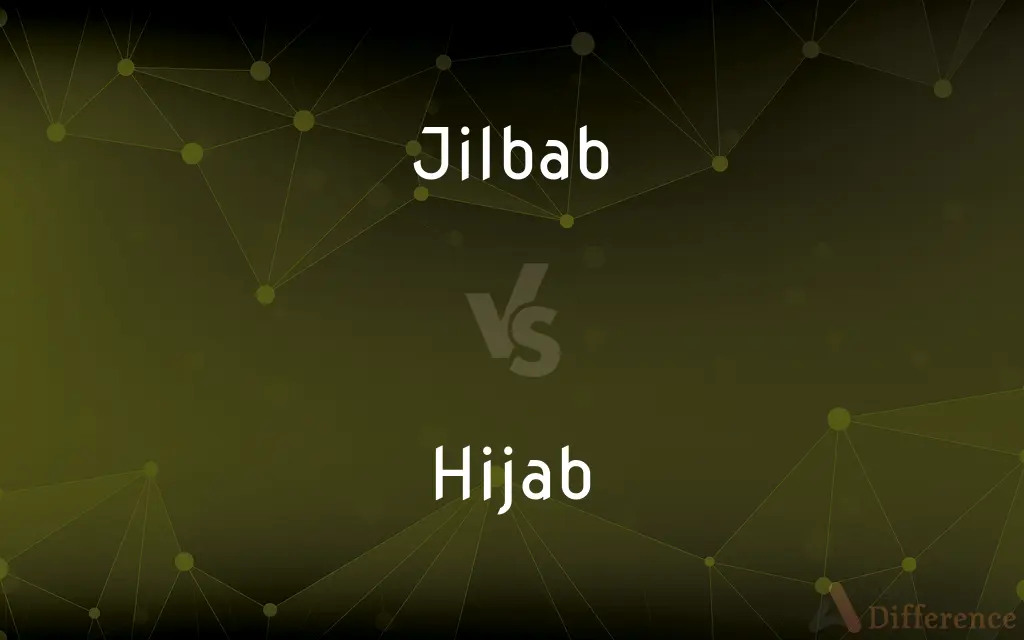Jilbab vs. Hijab — What's the Difference?
By Tayyaba Rehman — Updated on September 23, 2023
Jilbab is a loose-fitting, full-length garment that covers the entire body except the face, hands, and feet. Hijab primarily refers to a headscarf that covers the hair, neck, and often shoulders, but not the face.

Difference Between Jilbab and Hijab
Table of Contents
ADVERTISEMENT
Key Differences
Jilbab and Hijab are both garments worn by Muslim women for the purpose of modesty, but they are distinct in terms of their design and the body parts they cover. A Jilbab is a loose, full-length garment that covers the entire body except for the face, hands, and feet. In contrast, a Hijab is primarily a headscarf that covers the hair, neck, and often the shoulders, but leaves the face exposed.
The Jilbab is usually worn over regular clothes and resembles a long robe or a cloak. It is designed to conceal the shape of the body and is often accompanied by a headscarf or a Hijab. On the other hand, the Hijab focuses on covering the head and is worn in various styles and fabrics, depending on individual preference and cultural influences.
In terms of cultural and regional variations, the Jilbab is more commonly seen in certain Middle Eastern and Southeast Asian countries. The Hijab has broader global adoption and is more versatile, often seen in various styles across different Muslim communities worldwide.
The terms Jilbab and Hijab are sometimes used interchangeably, but this is not technically correct. While a Jilbab could be worn with a Hijab, they serve different purposes and offer different levels of coverage. The Hijab is more focused on modesty of the head and upper body, while the Jilbab aims for full-body modesty.
Comparison Chart
Body Parts Covered
Entire body except face, hands, feet
Head, neck, sometimes shoulders
ADVERTISEMENT
Garment Type
Full-length, robe-like
Headscarf
Versatility
Less versatile, specific design
More versatile, various styles
Regional Adoption
More common in Middle Eastern and Southeast Asian countries
Broader global adoption
Accompanies
Often worn with a headscarf or Hijab
Can be worn alone or with other modest garments
Compare with Definitions
Jilbab
Covers the entire body except the face, hands, and feet.
The Jilbab provided complete coverage, complying with her religious beliefs.
Hijab
A headscarf worn by Muslim women.
She chose a colorful Hijab to wear for the day.
Jilbab
Often worn over regular clothes.
She put on a Jilbab before leaving the house.
Hijab
Broadly adopted globally in Muslim communities.
Hijabs are worn by Muslim women worldwide.
Jilbab
A full-length, loose-fitting Islamic garment.
She wore a Jilbab over her everyday clothes for modesty.
Hijab
Worn in various styles and fabrics.
She liked experimenting with different Hijab styles.
Jilbab
Common in certain Middle Eastern and Southeast Asian countries.
Jilbabs are a common sight in many Muslim-majority countries.
Hijab
Focuses on modesty of the head and upper body.
The Hijab is an important part of her modest attire.
Jilbab
Frequently paired with a headscarf or Hijab.
She wore a matching Hijab with her Jilbab.
Hijab
Covers the hair, neck, and sometimes shoulders.
Her Hijab was wrapped tightly, covering her hair and neck.
Jilbab
A long, loose-fitting coat or similar garment worn by some Muslim women to fulfil hijab.
Hijab
A hijab (; Arabic: حجاب, romanized: ḥijāb, pronounced [ħɪˈdʒaːb] in common English usage) is a religious veil worn by Muslim women in the presence of any male outside of their immediate family, which usually covers the hair, head and chest. The term can refer to any hair, head, face, or body covering worn by Muslim women that conforms to Islamic standards of modesty.
Jilbab
A loose, long-sleeved, full-length overgarment worn by Muslim women.
Hijab
Any of several cloth head coverings worn by Muslim women.
Hijab
The veiling of women in some Islamic societies, customarily practiced in order to maintain standards of modesty.
Hijab
The practice, among Muslim women, of covering the body after the age of puberty in front of non-related adult males.
Hijab
(countable) A traditional headscarf worn by Muslim women, covering the hair and neck.
Hijab
A headscarf worn by Muslim women; conceals the hair and neck and usually has a face veil that covers the face
Hijab
The custom in some Islamic societies of women dressing modestly outside the home;
She observes the hijab and does not wear tight clothing
Common Curiosities
What is a Jilbab?
A Jilbab is a loose, full-length Islamic garment covering the body except for the face, hands, and feet.
Are there different styles of Hijabs?
Yes, Hijabs come in various styles, fabrics, and colors.
Can men wear a Jilbab or Hijab?
Traditionally, these garments are worn by Muslim women for the purpose of modesty.
What is a Hijab?
A Hijab is a headscarf that covers the hair, neck, and sometimes the shoulders, but leaves the face exposed.
Can a Jilbab be worn with a Hijab?
Yes, a Jilbab is often worn with a Hijab or another type of headscarf.
Are Hijabs worn in non-Muslim countries?
Yes, Hijabs are worn by Muslim women worldwide, including in non-Muslim countries.
What do you wear under a Jilbab?
Regular clothes are typically worn under a Jilbab.
Do both Jilbab and Hijab serve the same purpose?
Both are worn for modesty in Islamic tradition, but they differ in design and the body parts they cover.
Is wearing a Hijab mandatory in all Muslim countries?
No, wearing a Hijab depends on individual choice and specific cultural or legal mandates.
Are Jilbabs and Hijabs only black?
No, they come in various colors, although black is commonly worn in some regions.
Is a Jilbab versatile in style?
Jilbabs are generally less versatile in style compared to Hijabs.
Which garment provides more coverage?
A Jilbab provides more full-body coverage compared to a Hijab.
Can Jilbabs be stylish?
Yes, modern Jilbabs come in various fabrics and patterns, allowing for a stylish yet modest look.
Is it disrespectful for non-Muslims to wear a Hijab?
Opinions vary, but wearing a Hijab respectfully and with understanding of its cultural significance is generally considered acceptable.
What is the cultural significance of a Jilbab?
The Jilbab is often worn for religious reasons and is rooted in Islamic traditions of modesty.
Share Your Discovery

Previous Comparison
Mildew vs. Mold
Next Comparison
Option vs. SelectionAuthor Spotlight
Written by
Tayyaba RehmanTayyaba Rehman is a distinguished writer, currently serving as a primary contributor to askdifference.com. As a researcher in semantics and etymology, Tayyaba's passion for the complexity of languages and their distinctions has found a perfect home on the platform. Tayyaba delves into the intricacies of language, distinguishing between commonly confused words and phrases, thereby providing clarity for readers worldwide.













































